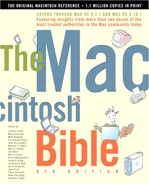Chapter 2. The Macintosh Family
Clifford Colby is the chapter editor.
Mike Breeden (MB), Christopher Breen(CB), David Morgenstern (DM), Jason O'Grady (JOG), and Daniel Drew Turner (DT) are the chapter coauthors.
Sharon Zardetto Aker (SA) was the editor of the seventh edition of The Macintosh Bible, from which portions of this chapter are taken.
At first, picking which Mac to buy was a snap: In 1984 you paid $2,495 for the original Macintosh, and Apple threw MacWrite and MacPaint in with the deal. Your big choice: Did you want an Apple carrying case for $99?
Ten years later, your choices were more varied—and bewildering. For example, just in the Performa line, at one time or another you could pick from (or wade through) the Performa 520, the Performa 5320CD, the Performa 630CD DOS Compatible, the Performa 6218CD, the Performa 6360, and 50-something other Performa models.
To make sense of any of it, you had to know processor speeds, if you wanted PCI or NuBus slots, how fast the CD-ROM drive read data, how big the hard drive was, and a dozen other speeds and sizes. In the past three years, Apple has whittled down its products to four trim lines—one portable model for consumers and another for professionals; one desktop model for consumers and another for professionals. As a Mac shopper, however, you still have to pick from removable storage options, networking transfer rates, battery lives, and of course, processor speeds. This chapter will get you going on what all that hardware inside your Mac does and help you sort through the machines that make up Apple's four hardware categories. (Other chapters—including Chapter 4, “Memory;” Chapter 5, “Storage;” Chapter 7, “Peripherals;” and Chapter 20, “Networking”—go much further. And for more guidance on what is the right Mac for you, check out Appendix A,“Buying Macs.”)
In This Chapter
Mac Innards
Understanding the CPU
Memory and RAM Caches
Starting Up Your Mac
A Bus Runs Through It: Graphics/Video and I/O
The Ages of the Desktop Macintosh
The Thoroughly Modern Mac: The Power Mac G4 Series
G4 Cubed
The Arrival of the PowerPC G3
The Golden Age and Pioneer Power Macs
Opening the Closed Box
A Macintosh by Any Other Name
PowerPC Pioneers
The iMac: Back in Fashion
Look and Feel
There's No Future in the Past
Looking Forward
She Comes in Colors
Jumping Ahead
PowerBooks: Macintosh to Go
Honey, I Shrunk the Mac!
Displays
Input Devices
Batteries
Power Management
The Energy Saver Control Panel and Pane
File Synchronization
Expansion Bays
PowerBook Upgrades
Travel Survival Tips
What to Bring
Power Management and Other Issues
Early PowerBook Models
The Mac Portable
The PowerBook 100, 140, 170
The PowerBook Duo
The PowerBook 500
The PowerBook 5300
The PowerBook 1400
The PowerBook 2400
The PowerBook 3400
The PowerBook G3
The PowerBook G3 (Kanga)
The PowerBook G3 Series 1998 (Main Street, Wall Street, PDQ)
The PowerBook G3 Series 1999 (101, Lombard, Bronze)
The PowerBook 2000 (102, Pismo, FireWire)
The PowerBook G4
The iBook
Upgrades
RAM
Storage
CPU Upgrades
Types of CPU Upgrades
PCI Cards
AGP Cards
